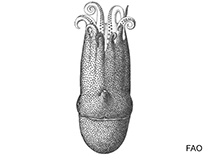Haliphron atlanticus Steenstrup, 1861
Gelatinous giant octopod| Native range | All suitable habitat | Point map | Year 2050 |

|
| This map was computer-generated and has not yet been reviewed. |
| Haliphron atlanticus AquaMaps Data sources: GBIF OBIS |
Upload your photos
Google image | No image available for this species;
drawing shows typical species in Alloposidae.
Google image | No image available for this species;
drawing shows typical species in Alloposidae.
Classification / Names Common names | Synonyms | CoL | ITIS | WoRMS
Cephalopoda | Octopoda | Alloposidae
Environment: milieu / climate zone / depth range / distribution range Ecology
Benthopelagic; depth range 0 - 6787 m (Ref. 96968). Subtropical
Distribution Countries | FAO areas | Ecosystems | Occurrences | Introductions
Circumglobal in tropical and subtropical waters.
Length at first maturity / Size / Weight / Age
Maturity: Lm ? range ? - ? cm Max length : 10.0 cm ML male/unsexed; (Ref. 96968); 69 cm ML (female)
Occurs in mesopelagic and bathypelagic in open waters but often associated with continental slopes (Ref. 114825). Depth range in open-ocean from surface to at least 1,260 m, over depths of up to 6,787 m. Collected in bottom trawls on continental shelves and slopes at depths of 100 to 3,173 m. Possibly not entirely pelagic, but might pass relatively short periods of its life cycle in open waters, soon returning to a life at the bottom especially on continental slopes. Females brood their eggs attached to the oral side of the arm bases near the mouth. Likely an intermittent spawner. The deep umbrella formed by the arms and webs of the female possibly serves as the main organ of locomotion/swimming. When mature, and before autotomized, the hectocotylus of males protrudes from the pouch opening on the inner surface of web between the second and fourth pairs of arms. Feeds on crustaceans and cephalopods (Ref. 96968).
Life cycle and mating behavior Maturity | Reproduction | Spawning | Eggs | Fecundity | Larvae
Members of the class Cephalopoda are gonochoric. Male and female adults usually die shortly after spawning and brooding, respectively. Mating behavior: Males perform various displays to attract potential females for copulation. During copulation, male grasp the female and inserts the hectocotylus into the female's mantle cavity where fertilization usually occurs. Life cycle: Embryos hatch into planktonic stage and live for some time before they grow larger and take up a benthic existence as adults.
Main reference
References | Coordinator | Collaborators
O'Shea, S. 2004. (Ref. 77104)
IUCN Red List Status (Ref. 130435)
Least Concern (LC) ; Date assessed: 20 August 2014
CITES status (Ref. 108899)
Not Evaluated
CMS (Ref. 116361)
Not Evaluated
Threat to humans
Human uses
| FishSource |
Tools
More information
Internet sources
BHL | BOLD Systems | CISTI | DiscoverLife | FAO(Publication : search) | Fishipedia | GenBank (genome, nucleotide) | GloBI | Gomexsi | Google Books | Google Scholar | Google | PubMed | Tree of Life | Wikipedia (Go, Search) | Zoological Record
Estimates based on models
Preferred temperature
(Ref. 115969): 1.9 - 5.2, mean 2.9 (based on 7163 cells).
Price category
(Ref. 80766):
Unknown.



